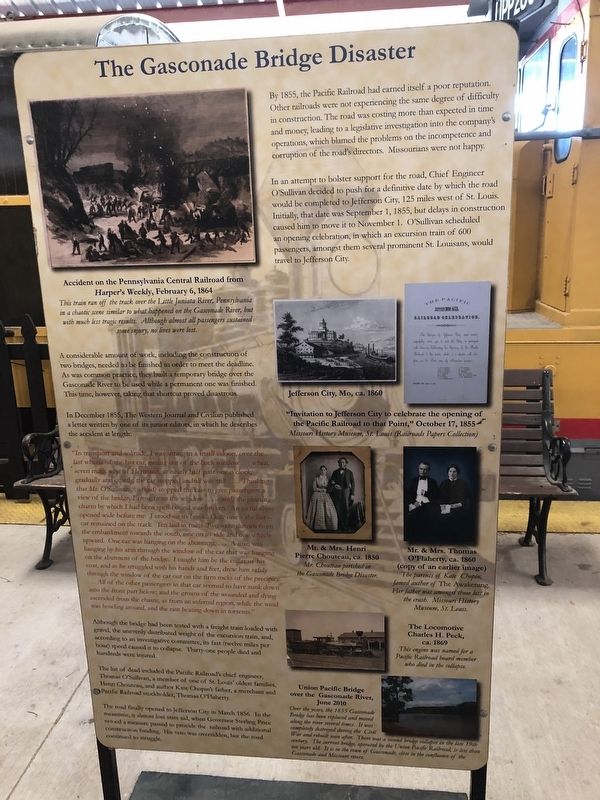National Museum of Transportation near Kirkwood in St. Louis County, Missouri — The American Midwest (Upper Plains)
The Gasconade Bridge Disaster
By 1855, the Pacific Railroad had earned itself a poor reputation. Other railroads were not experiencing the same degree of difficulty in construction. the road was costing more than expected in time and money, leading to a legislative investigation into the company's operations, which blamed the problems on the incompetence and corruption of the road's directors. Missourians were not happy.
In an attempt to bolster support for the road, Chief Engineer O'Sullivan decided to push for a definitive date by which the road would be completed to Jefferson City, 125 miles west of St. Louis. Initially, that date was September 1, 1855, but delays in construction caused him to move it to November 1. O'Sullivan scheduled an opening celebration, in which an excursion train of 600 passengers, amongst them several prominent St. Louisans, would travel to Jefferson City.
A considerable amount of work, including the construction of two bridges, needed to be finished in order to meet the deadline. As was common practice, they built a temporary bridge over the Gasconade River to be used while a permanent one was finished. This time, however, taking that shortcut proved disastrous.
In December 1855, The Western Journal and Civilian published a letter written by one of its junior editors, in which he describes the accident at length:
"In transport and solitude, I was sitting in a small saloon, over the last wheels of the last car, gazing out of the back window... when, seven miles west of Hermann, at nearly half past one o'clock, gradually and quietly, the car stopped and all was still.... Thinking that Mr. O'Sullivan... (had stopped) the cars to give passengers a view of the bridge, i arose from the window.... (and) the pleasing charm by which I had been spell-bound was broken. A awful abyss opened wide before me. I stood on its brink. Only one— the last— car remained on the track. Ten laid in ruins. Two were thrown from the embankment towards the south, one on its side and one wheels upward. One car was hanging on the abutment.... A man was hanging by his arm through the window of the car that was hanging on the abutment of the bridge. I caught him by the collar of his coat, and as he struggled with his hands and feet, drew him safely through the window of the car out on the firm rocks of the precipice... All of the other passengers in that car seemed to have sunk down into the front part below; and the groans of the wounded and dying ascended from the chasm, as from an infernal region, while the wind was howling around, and the rain beating down in torrents."
Although the bridge had been tested with a freight train loaded with gravel, the unevenly distributed weight of the excursion train, and, according to an investigative committee, its fast (twelve miles per hour) speed caused it to collapse. Thirty-one people died and hundreds were injured.
The list of dead included the Pacific Railroad's chief engineer, Thomas O'Sullivan, a member of one of St. Louis' oldest families, Henri Chouteau, and author Kate Chopin's father, a merchant and Pacific railroad stockholder, Thomas O'Flaherty.
The road finally opened to Jefferson City in March 1856. In the meantime, it almost lost state aid, when Governor Sterling Price vetoed a measure passed to provide the railroad with additional construction funding. His veto was overridden, but the road continued to struggle.
Over the years, the 1855 Gasconade Bridge has been replace and moved along the river several times. It was completely destroyed during the Civil War and rebuilt soon after. There was a second bridge collapse in the late 19th century. The current bridge, operated by the Union Pacific Railroad, is less than ten years old. It is in the town of Gasconade, close to the confluence of the Gasconade and Missouri rivers.
Erected by Museum of Transportation.
Topics. This historical marker is listed in these topic lists: Bridges & Viaducts • Disasters • Industry & Commerce • Railroads & Streetcars. A significant historical month for this entry is March 1856.
Location. 38° 34.325′ N, 90° 27.634′ W. Marker is near Kirkwood, Missouri, in St. Louis County. It is in National Museum of Transportation. Marker can be reached from Barrett Station Road east of Old Dougherty Ferry Road, on the right when traveling east. Touch for map. Marker is at or near this postal address: 3015 Barrett Station Road, Saint Louis MO 63122, United States of America. Touch for directions.
Other nearby markers. At least 8 other markers are within walking distance of this marker. Civil War Destruction (here, next to this marker); Riot in the Tunnels (here, next to this marker); The Pacific Railroad Controversy (here, next to this marker); Ground-breaking! (a few steps from this marker); #2804 (a few steps from this marker); The Pacific Railroad of Missouri: Audacious Dreams & Harsh Realities (a few steps from this marker); The Missouri Pacific Today... (a few steps from this marker); #750 (a few steps from this marker). Touch for a list and map of all markers in Kirkwood.
Credits. This page was last revised on April 24, 2020. It was originally submitted on April 28, 2019, by Devry Becker Jones of Washington, District of Columbia. This page has been viewed 414 times since then and 51 times this year. Photo 1. submitted on April 28, 2019, by Devry Becker Jones of Washington, District of Columbia.
